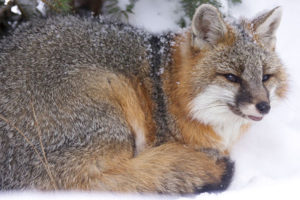
The new strain of canine distemper virus was found in two gray foxes similar to these foxes. PHOTO: VERMONT FISH AND WILDLIFE DEPARTMENT
A distinct strain of canine distemper virus, which is a widespread virus of importance to wildlife and domesticated dogs, has been identified in wild animals in New Hampshire and Vermont, according to pathologists with the New Hampshire Veterinary Diagnostic Lab at the University of New Hampshire (UNH). No virus in this distinct subgroup of canine distemper virus has yet been reported in a domesticated dog.
“A distinct strain of canine distemper virus is circulating in multiple wildlife species in two contiguous states in Northern New England,” says David Needle, senior veterinary pathologist and assistant clinical professor in a press release. “This strain is significantly distinct from the vaccine strains. A member of genus Morbillivirus that includes measles, canine distemper virus is highly contagious and causes severe disease in infected animals.”
The new strain of canine distemper virus was identified by UNH pathologists in collaboration with colleagues at Cornell University, University of Georgia, Northeast Wildlife Disease Cooperative, New Hampshire Fish and Game, and Vermont Fish and Game. Over a one-year period, pathologists diagnosed canine distemper virus infection in eight largely carnivorous mammals in southeastern New Hampshire and north central Vermont. The animals included three fishers, two gray foxes, one skunk, one raccoon and one mink.
Pathologists found all animals were infected with a distinct strain of the virus that had been identified only in a single raccoon in Rhode Island in 2004, which was not described in any publication. The eight animal cases also represent the only reports of any canine distemper virus isolated from New Hampshire and Vermont in the GenBank database.
“This can and may already be having an impact on the population of wild mesocarnivores in New Hampshire and New England,” says Needle. “These animals are an integral part of the varied ecosystems of wild New Hampshire and New England, filling important niches in predator-prey relationships and pest control. Any decrease in wildlife populations is a loss to the rich wild diversity. The affected species also are furbearing mammals that serve as part of the cultural heritage of the northern sportsman.”
Canine distemper virus vaccination is part of the core vaccine protocols for domesticated dogs. All dogs should be vaccinated routinely. Canine distemper virus infection in dogs is most often characterized by respiratory disease, oral and nasal discharge, gastroenteritis, and as the disease progresses, neurological disease. This is a severe, highly pathogenic and highly contagious disease, so any suspected infection should be reported immediately to a veterinarian. Any unvaccinated animals should be vaccinated.
The results of this case are presented in the Journal of Veterinary Diagnostic Investigation. The research is supported by the New Hampshire Agricultural Experiment Station and the State of New Hampshire.
The post New canine distemper strain found in New Hampshire, Vermont appeared first on Pest Management Professional.
from Pest Management Professional https://www.mypmp.net/2019/05/09/new-canine-distemper-strain-found-in-new-hampshire-vermont/
Sacramento CA
nice post sir i really like
ReplyDeleteYBN University
nice post thxu for good info
ReplyDeleteChaudhary Ranbir Singh University
nice post sir i really like this
ReplyDeleteCHSL Recruitment 2020
HSSC Recruitmen